The road to the spawning area is long and winding. The igapó forest is not flooded, but very humid. The ground, covered with leaves, is slippery, and you have to pay attention when you climb up and down the small gullies where the waters of the Xingu River slice through the terrain with dozens of small streams, which in the Amazon are called igarapés (creeks). Raimundo da Cruz e Silva, who is 47, traverses this path every day in order to check whether the water level has risen or fallen and if fish are reproducing. He checks the height of the water using measuring sticks installed on the perimeter, takes photos, and records videos and audio of what he calls “my spawning area”. Raimundo is one of twelve riverside and indigenous researchers who monitor the impact of the Belo Monte hydroelectric plant on the river’s ecosystems. Along with academic researchers from a number of Brazilian universities, they are part of the Observatory of the Volta Grande (Big Bend) of the Xingu, an independent effort that has produced the most accurate environmental analysis of the hydroelectric power plant’s impact on the river’s life.
The observatory’s mission is to produce data, information and scientific analysis that is presented both to the Brazilian Institute for the Environment and Renewable Natural Resources (Ibama) and to the Federal Public Prosecutor’s Office (MPF) to support technical opinions and provide the basis for legal actions.
We should take a moment to explain the idea of the spawning area: the scientist Jansen Zuanon, one of the greatest specialists in Amazonian ichthyology, who is a retired professor from the National Institute for Amazon Research (Inpa) and a member of the observatory, explains the forest peoples of the Big Bend of the Xingu, as the 130-kilometer stretch of the river is called, (and from which roughly 70% of the water is diverted to feed the Belo Monte plant’s turbines) have a different concept of spawning grounds. Their view of the spawning areas goes beyond the usual description, namely that of the upward movement that the fish make to spawn in the headwaters of the rivers. “In the case of the Xingu, in the stretch that contains a lot of rapids and waterfalls, the fish are in movement the whole time, and in fact the riverbank dwellers refer to the ‘piracemas’ or spawning areas as a combination of space and time. It is a moment in which the waters rise, and the fish make this upward movement. But not toward the headwaters, but in search of those places that have recently been flooded, and which are perfect for spawning,” the scientist says.
Every day a WhatsApp group is filled with photos and videos sent from various points of the Xingu’s Big Bend. Each image registers the location’s coordinates and the name of the spawning area visited. The observatory is made up of 40 people, including researchers from a number of fields and Brazilian universities, riverside people, indigenous people, and fishermen. This was a way to ensure the collection of daily information in relation to the Belo Monte plant’s impact on life. The photos and videos show measuring sticks that gauge the rise and fall of the waters in areas that should be flooded, but which are not; fruits that would be food for the fish, but now fall on the dry floor of the islands; and fish that are almost always very thin and with dead eggs inside their bellies. Based on this data, the Independent Environmental and Territorial Monitoring of the Big Bend of the Xingu (Mati-VGX) aims, by April of this year, to carry out a scientific analysis of the material and present an overview of the damage caused by the dams on the river.
The main coordinator of this work is Josiel Yudjá (Juruna), who is 26, lives on the Paquiçamba Indigenous Land and has a wealth of knowledge in relation to the region’s life cycles. As part of the Yudjá/Juruna people, Josiel is one of the “river’s owners” – one of the meanings given by the indigenous people to the name of his ethnic group. He grew up bathing and fishing in the Xingu and, along with other residents of the Big Bend, saw his world come to an end in 2016, when he was just 20 and witnessed the artificial and unannounced flood caused by the Belo Monte dam. He also saw the river’s behavior change because of the plant’s operation – the Xingu, the father and mother of the traditional communities, became unpredictable.
“It is very sad to see what is taking place right now in the Big Bend region,” says Josiel in a video sent to SUMAÚMA direct from the Zé Maria spawning grounds, which he has been monitoring on a daily basis since 2019. “What is happening here in the Big Bend of the Xingu is that the river is controlled by the Belo Monte hydroelectric power plant. Sometimes it is full, sometimes it is dry, there are days when the river rises quickly and other days when it dries up very quickly. This confuses the fish. There are areas that are known as sarobais [places where aquatic species feed and reproduce] that flood. The fish get confused, because they think that it is still the natural cycle, but it is no longer the case today, because it is controlled by the Belo Monte dam. […] Zé Maria Island was a nursery for fish that fed here on this island. Here, in this spawning ground, a number of freshwater fish species, curimatás (toothless characins), piau (leporinus) and trairão (hoplias lacerdae), used to come to spawn and needed a fairly large amount of water that floods part of the island. But since I began monitoring this spawning area, I have never seen the fish coming in to spawn. Their spawning season […] is from late January to February. But nowadays the water only arrives in April, because it is controlled by the Belo Monte dam, the fish can’t spawn, because by April the eggs are already dry inside the fish.”
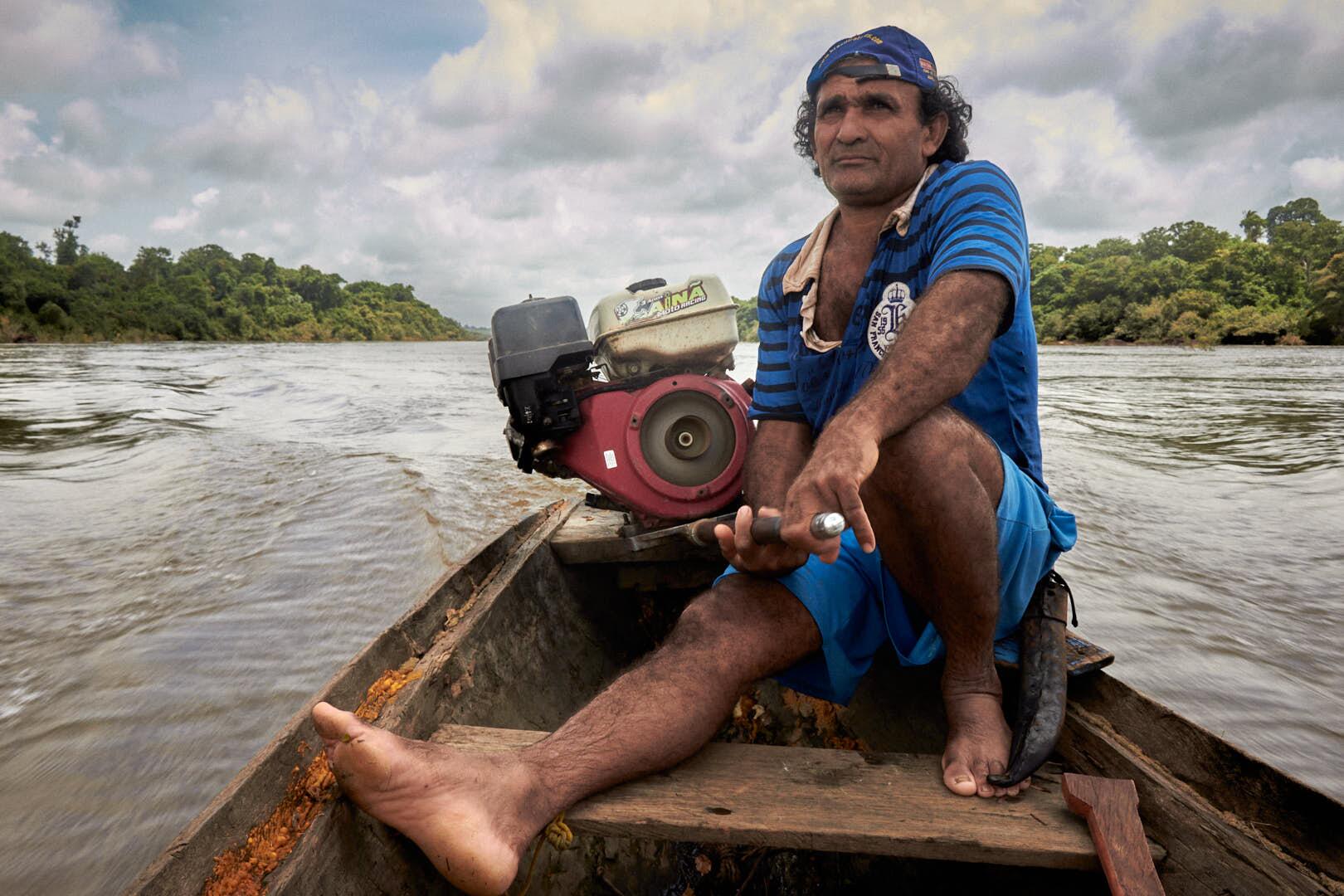
FOR THE FISHERMAN SEBASTIÃO BEZERRA LIMA, WHO IS INVOLVED IN THE INDEPENDENT MONITORING OF THE BIG BEND OF THE XINGU’S SPAWNING GROUNDS, ‘THE FISH BECAME RIVER ILLITERATE’. PHOTO FROM JANUARY 14, 2023: SOLL SOUZA/SUMAÚMA
Sebastião Bezerra Lima, 51, says that “the fish have become river illiterate”, because it is Belo Monte that now controls the water and the river has become erratic. He is also involved in the independent monitoring of the Big Bend’s spawning grounds. SUMAÚMA was able to observe there is no way for the residents or the fish to have any security regarding the amount of water released. In the space of a single week, the riverbank dwellers received three consecutive messages from Norte Energia via WhatsApp: in the first message, the company said the water level was going to drop, in the second, it was going to rise, and in the third, the warning was that there would be a further rise in the river’s flow. The conditions for the use of the waters are defined in the “concession” —the authorization to use the water for power generation— granted by the National Water and Sanitation Agency (ANA). SUMAÚMA contacted ANA, but had not received any response by the time this report was published .
The communications from Norte Energia, Belo Monte’s owner, in relation to the decrease or increase in the water flow only began to be sent to residents after considerable pressure from them and from the region’s authorities. The idea at least, is to avoid a repeat of what happened during the 2016 flood, when no one was informed of the sudden release of water, and which only did not result in a greater tragedy because it occurred early in the evening, when the residents had already gone back to their homes. However, for many families, these warnings never come, because they do not have telephones or internet, which greatly increases their risk of suffering as a result of a sudden flood.
On January 8, a sudden rise in the waters flooded Sebastião’s boat, which was destroyed. He also lost 40 liters of gasoline, all his fishing gear and the food he was taking home. After turning to his neighbors for help, he managed to convince Norte Energia to send men to rescue his boat – his means of transportation and work tool. But all the company’s employees did was to take his boat to the island where he lives, without any type of repairs, even though it is an essential item for his life. “It’s not fair what they do to the riverbank dwellers and the fishermen. They don’t pay any attention whatsoever to us. It was their duty to do maintenance, repair and make compensation,” he says with anger. Sebastião, who lives close to the Amazon’s largest hydroelectric power plant, has had his life affected by Belo Monte in many ways. But he lives in a region without electricity. “All I wanted was a solar panel, to charge my cell phone,” says the fisherman.
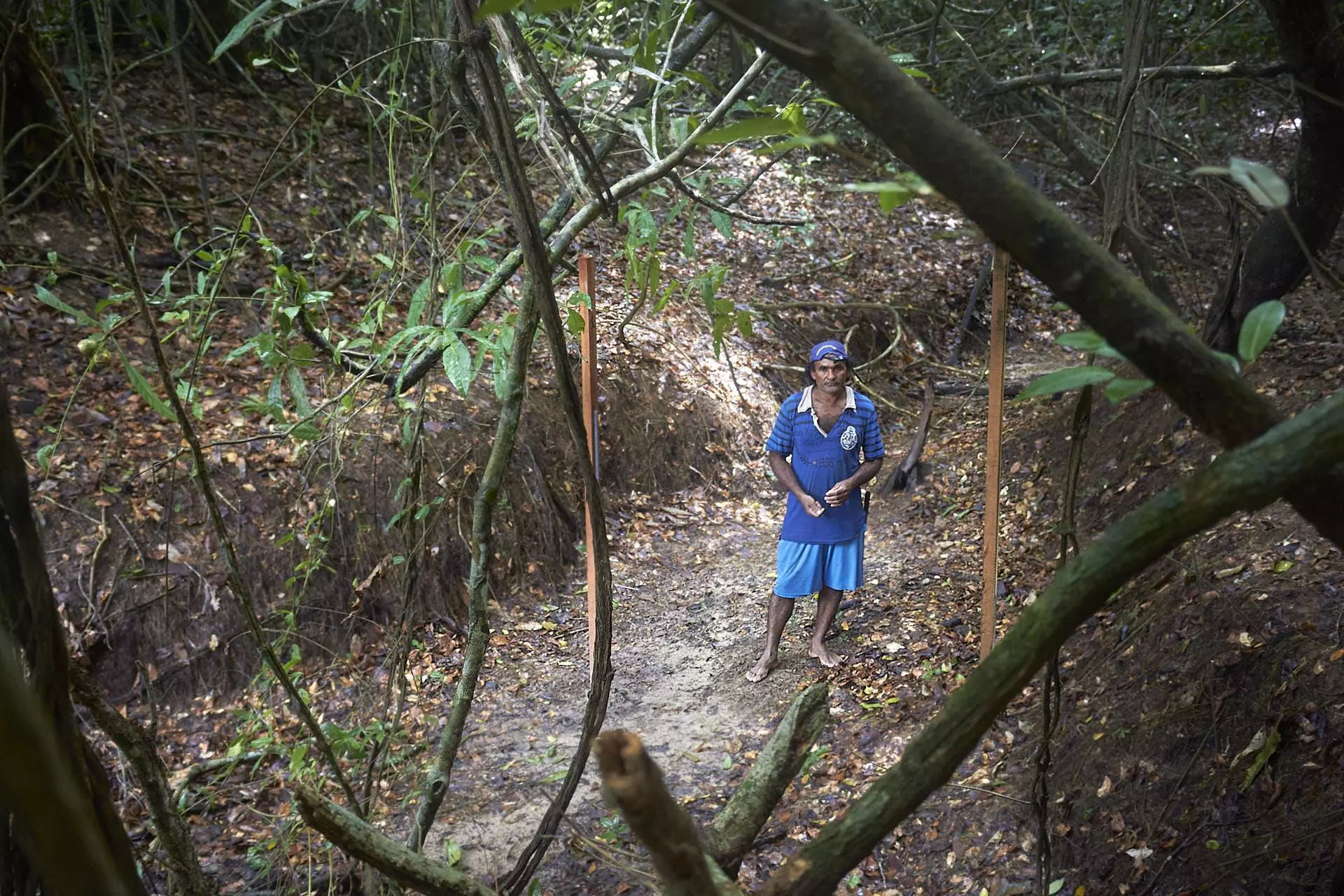
A DRY RIVERBED WHERE THERE WAS ONCE A RIVER. SEBASTIÃO BEZERRA LIMA USES RULERS TO MEASURE THE ABSENCE OF WATER FISH NEED TO REPRODUCE. PHOTO FROM JANUARY 2023: SOLL SOUSA/SUMAÚMA
Sebastião baptized the spawning ground that he monitors Catitu, because one day he arrived there and saw an anaconda devouring a catitu [a type of wild pig very popular in the Amazon]. “We can forget about the spawning ground, because there won’t be one there anymore. They just release a little bit of water. It’s not like it used to be, when the water would fill up bit by bit, back then the fish understood, they knew they were going to reproduce. That’s the way the fish are, I am a fisherman and I know. The fish would enter the creek and spawn. After 24 hours, you could look and the eggs already had those little eyes. The way things are now, the fish don’t understand, because before they get there, the water already dries up and comes back ,” he said, standing next to the measuring stick that marked all the centimeters that the water should have risen. In some places, it should be showing 2 to 3 meters at that moment, but instead of which it wasn’t even up to 1 meter.
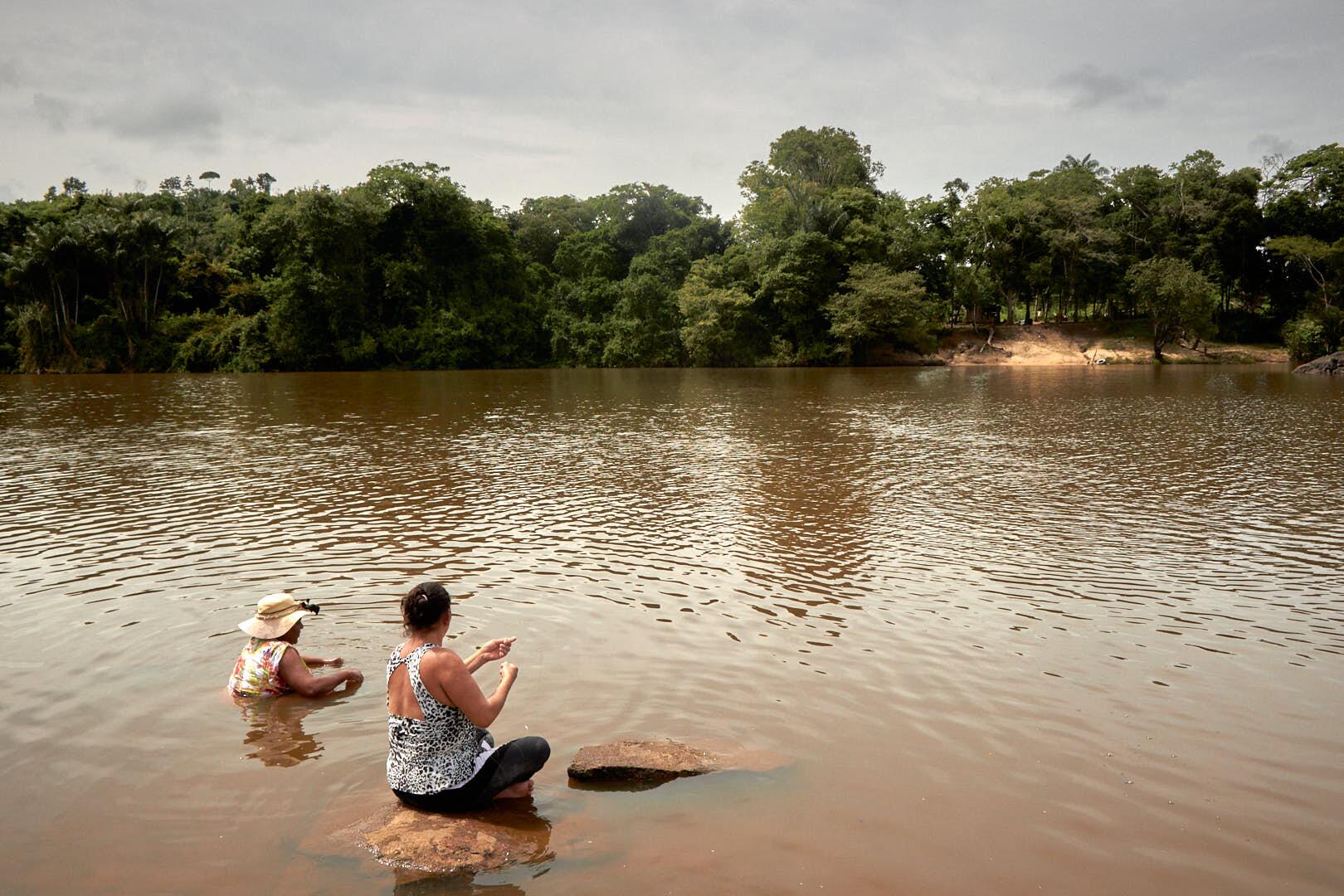
ON THE MORNING OF JANUARY 15, 2023, TWO WOMEN TRY TO FISH IN THE SO-CALLED BIG BEND, WHERE AQUATIC SPECIES ARE FINDING IT INCREASINGLY DIFFICULT TO REPRODUCE BECAUSE OF THE BELO MONTE DAM. PHOTO: SOLL SOUZA/SUMAÚMA
How to read the Xingu River
What Sebastião explains with his science as a fisherman and riverside dweller, the scientist Jansen Zuanon calls an “environmental signal”, on which aquatic species depend to start the annual reproduction process. “Fish and other living organisms need a response from the environment, a safe, reliable environmental signal, which usually makes its appearance in a long sequence. With each passing day the volume of water increases, the flood gradually progresses, and that there is a clear signal. This prevents the fish from entering, for example, an area that will suddenly dry up. Or that they spawn, wasting all the energy accumulated throughout the cycle of an entire year,” he explains.
When the ecosystem’s balance is mercilessly affected, says the researcher, the whole logic of natural life is betrayed. “The most important thing for an individual of a species is to leave offspring. And if the fish spawns in an area that is going to dry up, it has wasted the opportunity to reproduce. For an individual of any species on the planet, the worst way to die is without leaving offspring. When Belo Monte causes these fluctuations, this whole balance is destroyed.”
The image of Belo Monte controlling the waters of the river makes sense. One of the major symbols of appropriation is the Big Bend of the Xingu, which has had its name changed in official documents, and is now bureaucratically referred to as “Reduced Flow Stretch”. Control over the river is also explicitly asserted in the Boat Transposition System, operated by a Norte Energia subcontractor. Made under pressure from the residents, without it there would be no way to reach the city of Altamira once the power plant was built. Realizing that the road would also be blocked, the residents fought to include transposition in Belo Monte’s licensing process. Even so, it is a humiliating routine for those who beforehand had the full freedom to come and go along the river as they pleased. Today, all of those who intend to enter or exit the Big Bend are required to stop their boats when they approach the Pimental dam. The pilots have to fill out a form giving the reason as to why they are going up and down the river and, while the passengers get into a van, the boat is taken by tractor to the other side of the dam, so that they can then continue their journey. They need to give explanations about their movements on the river as if the company were a national border post, as if they were entering another country.
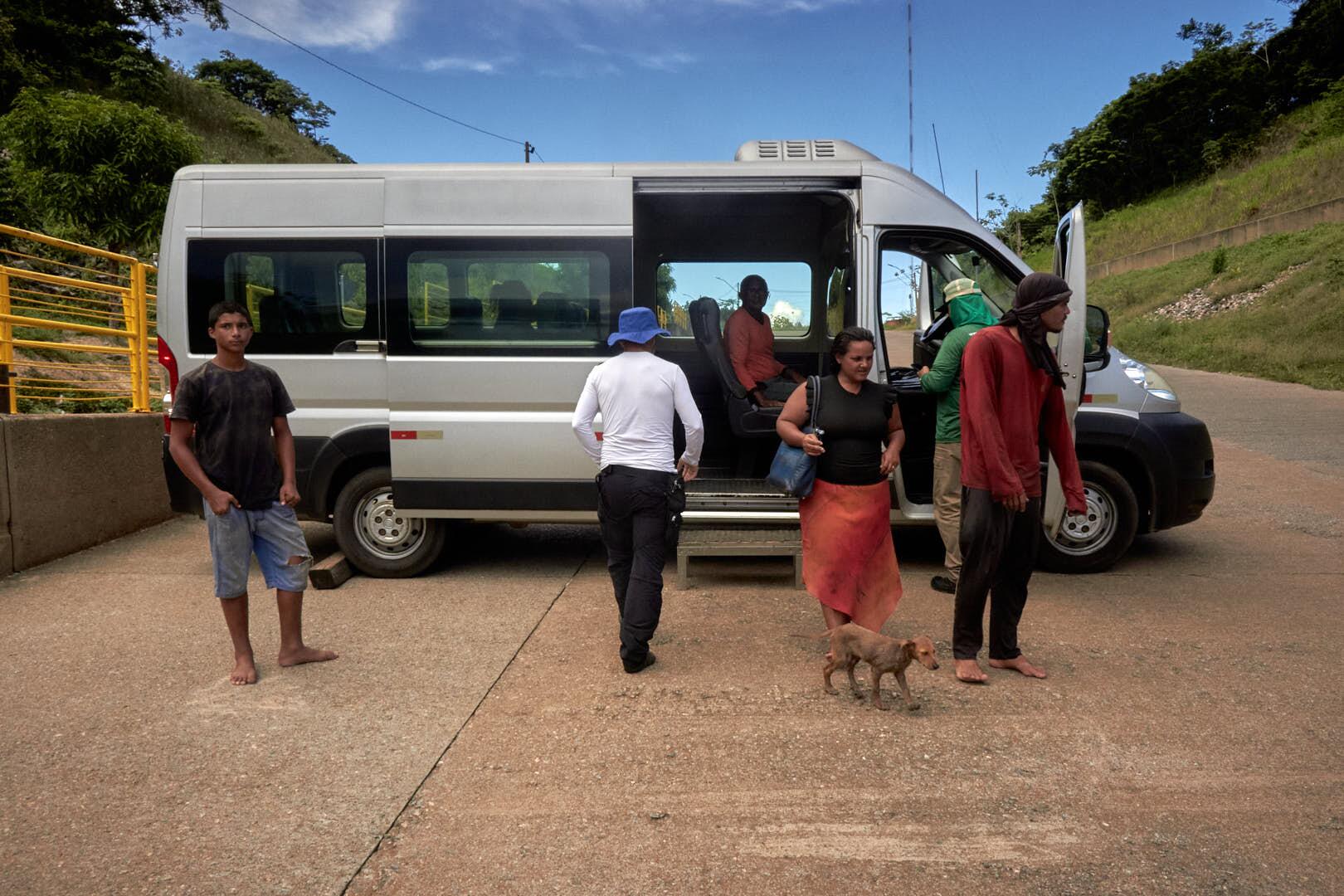
NORTE ENERGIA, BELO MONTE’S OWNER, CONTROLS THE RIVER. TO ENTER OR EXIT THE BIG BEND OF THE XINGU, THE BOATS’ PASSENGERS ARE TAKEN BY A VAN WHILE THE BOAT IS TRANSPORTED BY TRACTOR TO THE OTHER SIDE OF THE DAM, SO THAT THEY CAN THEN CONTINUE THEIR JOURNEY. PHOTO FROM JANUARY 16, 2023: SOLL SOUZA/SUMAÚMA
Jansen believes it is vital for the work of the independent environmental monitors to be taken into account by Ibama in its analysis on whether to renew the power plant’s operating license. He explains Norte Energia is obliged by the licensing and inspection agencies to conduct its own monitoring. However, this corporate monitoring, due to the fact that it is carried out at regular intervals and involves collecting samples during the four periods of the year – flood, full, receding and dry —offers averages of the river’s level that are not accurate measurements of what happens in the day-to-day life of the Xingu. “You can imagine it like this: the river went up, went down, went up, went down, but in overall average terms it went up. Then you can say that everything is fine. But for the fish that were in the water, they were getting these contradictory signals the whole time. So, when you use the traditional data sampling methodology, you cannot verify this kind of problem,” he says.
In this sense, the monitoring carried out by the residents themselves appears to be a simple, cheap, and above all efficient solution because it takes into account the knowledge of those who understand the river much better than any other researchers. “They [the technicians] are not looking at the fish like the river dwellers do every day. The local monitors have a much more refined view of the process and one that’s in real time. Why aren’t they included in the licensing? Why doesn’t Ibama listen to them? Our efforts now are precisely for this purpose,” he says. “It is a struggle. The concessionaire itself monitors its impacts and it is clear that it is in its interest to say that everything is fine. So, it is an absurd difference of perspective. What we are proposing is the local populations should conduct and be directly involved in the environmental monitoring process. It’s good for everybody.” And it is particularly good for the Xingu and for the forest, for nature and for the health of the planet and its inhabitants.
Before there was a Belo Monte, in the hundreds, perhaps thousands, of spawning grounds found along the 80-mile stretch of the Xingu known as the Big Bend, the fish reveled in breeding. Rosilene Souza dos Santos’ family is very familiar with this. Since the 1980s, Rosilene has lived in the community of Goianinho on a small piece of land close to the piracema, as spawning grounds are called. She witnessed the many changes wrought when Belo Monte dammed up the Xingu. The waters never filled the piracema again, and fish are now scarce. When she took the SUMAÚMA team to visit this place that is now a non-place, Rosilene, hand on her chest, said softly, “Us people who grew up here, when we go to the piracema, it hurts.”
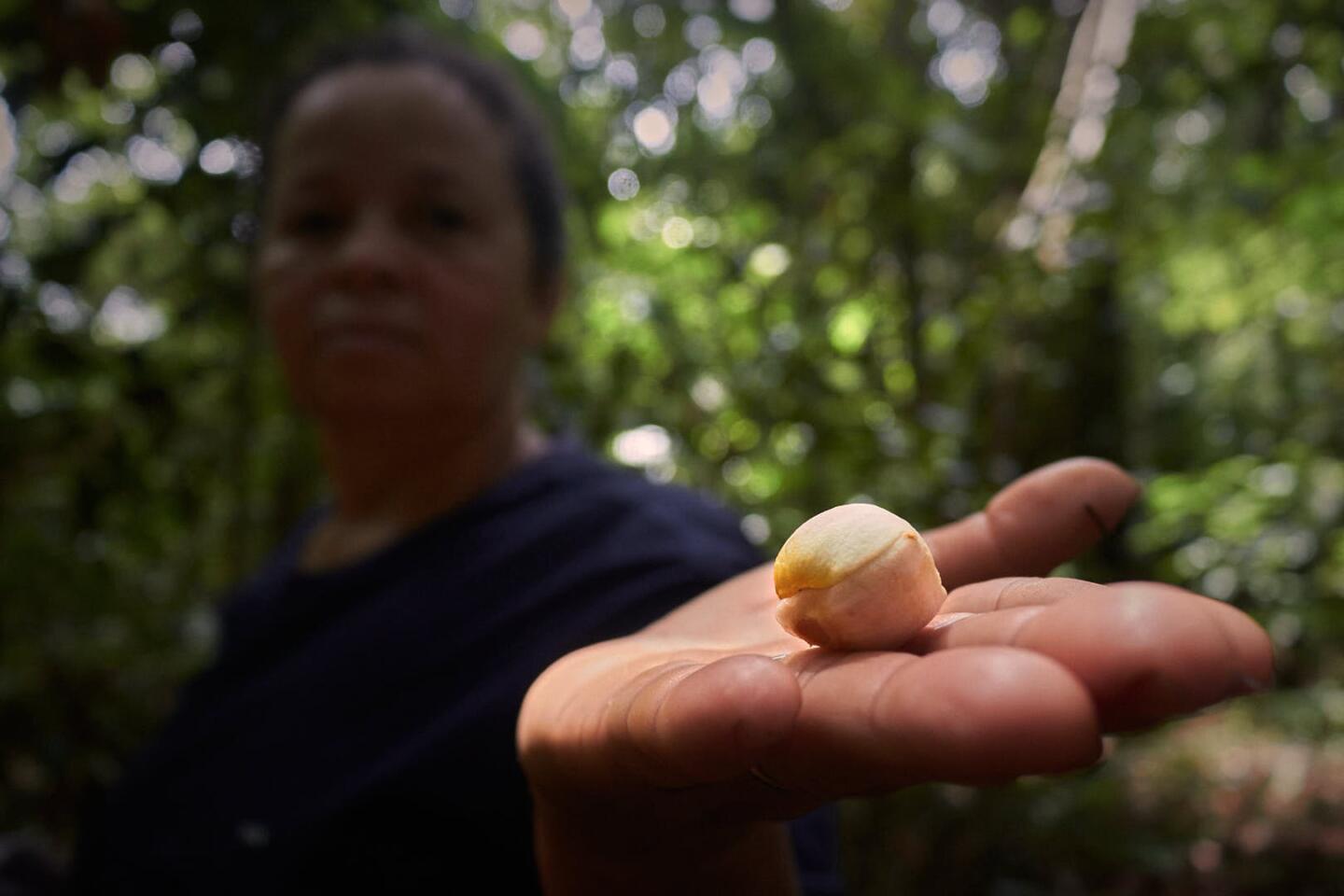
Rosilene Sousa dos Santos shows a nut tree flower that would be food for the fish if there were a spawning season. Today, the fruit falls onto the dry ground. Photo: Soll Sousa/SUMAÚMA
Norte Energia’s claims
In a statement, Belo Monte’s concessionaire says it is unaware of “any truly scientific data regarding damage and its causes” and says it has “no knowledge of any humanitarian crisis affecting the population in its direct area of influence, as a result of the power plant’s operation.” Below is it’s response to SUMAÚMA’s questions:
“The matrix of impacts generated at the time of the previous environmental studies of the Belo Monte Hydroelectric Power Plant indicated what could affect the socioeconomic activities of the populations living on the margins of the Reduced Flow Stretch (TVR), as well as the flora and fauna of the Big Bend of the Xingu in this 100 km segment. For this reason, six years of hydrograph tests were planned, and the Integrated Management Plan for the Big Bend of the Xingu (PGIVGX), which is part of the Basic Environmental Project (PBA), as well as specific projects in the TVR, including those of the indigenous component (PBA-Indigenous Component), are being carried out. These were measures aimed at monitoring and mitigating the occurrence of the aforesaid impacts, together with the participation of and guidance from the appropriate environmental agency, which oversees and monitors, as well as directs the way in which the projects and mitigation and compensation measures are implemented. The company is unaware of any truly scientific data in relation to damage and its causes, and has no knowledge of any humanitarian crisis affecting the population in its direct area of influence, as a result of the power plant’s operation.
Throughout 2022, Norte Energia continued to develop these mitigation measures in the region by means of the Term of Environmental Commitment signed with Ibama, in addition to maintaining continuous dialogue with the riverside communities and indigenous peoples of the Big Bend of the Xingu, for the purpose of working together on issues of mitigation and compensation for impact by means of participatory monitoring, actions aimed at improving access to water, basic sanitation, productive activities in terms of fish farming, the planting of cocoa and foodstuffs, improvements in the health system and land access[M11] , in addition to prioritizing measures to support navigation in the region. Norte Energia also reinforced its process of actively listening to the communities, studying and sharing with the riverside dwellers and indigenous peoples of the Xingu’s Big Bend new proposals for measures to ensure the improvement of the region’s biodiversity conditions”.
Fact check: Plínio Lopes
Spell check (Portuguese): Elvira Gago
Translation into Spanish: Meritxell Almarza
English translation: Mark Murray
Photography editing: Marcelo Aguilar, Mariana Greif and Pablo Albarenga





